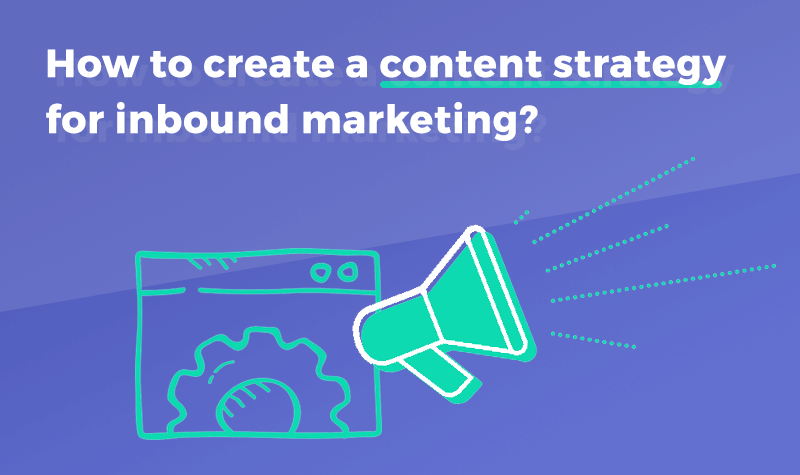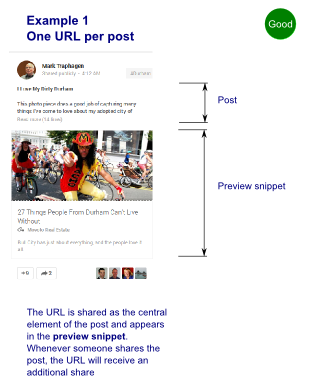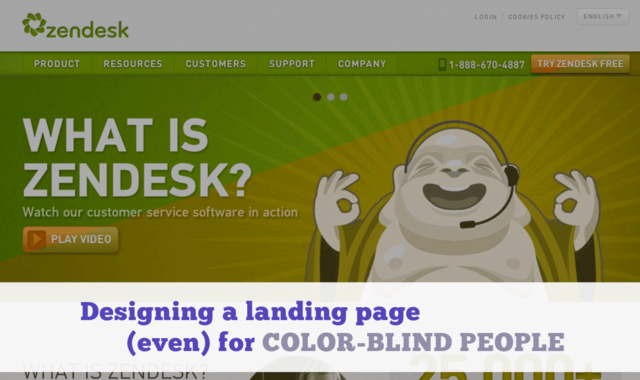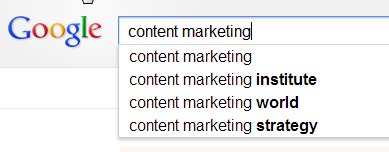In this post we are introducing the concept of inbound/content mapping: a framework that allows companies to create and describe their content marketing strategy on a macro level. This framework helps to keep all the inbound marketing team aligned when it comes to content creation. It has the advantage of being useful for any inbound maturity levels: whether you are just starting or if you already have good confidence in your target audience and tactics.
Content creation is a general term that can be used for several distinct goals among which:
- inbound marketing acquisition (the focus of this article)
- brand awareness
- e-commerce product pages generation
- customers or employees training, onboarding
- customer retention
- SEO
- …
Because we focus especially on generating new commercial opportunities here, our main goals will be to attract, convince and convert readers into prospects then into customers. It is important that both the inbound strategy and content marketing plan stay aligned. We will try to give you a clear and straightforward method to bind the two together in this post. But before we go any further, check out the free content mapping template we created for you.
1 – What is your high-level goal?
Let’s stay for a moment at the macro level. As Simon Sinek would say, we should start with “Why?”, so let’s do it together: why do you invest in content marketing?
Obviously, your answer should be aligned with your business goals. It will allow you to control the relevance of your actions by assessing the content marketing ROI. The tracked metrics will help you to decide what content to create and what topic to address (but we will come back later when we discuss [KPIs]).
You might be doing content marketing for various purposes in your business and your content team is not necessarily driven by revenue-related metrics (but it’s often the case).
Here is a non-exhaustive list of such business-oriented goals related to content marketing:
- Directly improving revenue by generating new leads (inbound marketing),
- Accelerating sales cycle by producing expert content that supports Sales Rep work,
- Improving brand image and notoriety,
- Reducing customer support requests by creating resources and training material,
- Increasing up-sell/cross-sell events by helping customers to understand the value of your offers
- …
Once you are clear with yourself you can proceed and discover the rest of the methodology. We will explain how to put your customers at the center of all your actions.
2 – Inbound Marketing and Content Mapping
The Inbound Marketing approach is focusing on Personas (prototypes of your target customers) to help you run your marketing activities. The more you will know your audience, the more efficient you will be at attracting people on your blog and converting them on your landing pages.
Put another way, this framework will allow you to create a content strategy that aligns your personas’ pains with the buyer’s journey. If you follow it, every piece of content will in theory help at least one of your persona for a daily pain, at a different maturity level.
But enough words, let’s describe these three topics in detail
Persona
A persona is an imaginary character representing a group (or segment) of your ideal customers or prospects. The goal for you is to document “who you are talking to”.
Side note: Persona is a Latin word. In Latin, a word that ends with -a have a plural form in -ae. This explains why you will often read “Personae” instead of “Personas”. These are the same word.
In concrete terms, a persona comes in the form of a descriptive sheet that summarizes the characteristics of your fictional character by breaking them down into different sections:
- Socio-demographic characteristics (sex, age, place of life, occupation, income level, level of education …),
- Psychographic characteristics (opinions, beliefs, lifestyles, values, …),
- Job occupation,
- Job focus/objectives,
- Main challenges/issues,
- Fears,
- Success criteria,
- Sources of information,
- Verbatims heard in the field or keywords used during interviews,
- Your product Sales Pitch for the persona studied,
- Motivators.
This list is obviously different from one company to another. You can adjust it to your needs, but the ultimate objective is to know your customer. If you know your customer, you will be able to create your content strategy on a solid basis. The most important information from the Persona document is the “Challenges” section.
Personas Challenges
To create content that converts, you have to be relevant to your readers/prospects. So, when we will set up the editorial plan, our Personas challenges (daily pains) will be one of the most important inputs.
The idea is to address our Buyer Personas problems with our content. We have to help them achieve their objectives. If you help them, they will recognize you as a trusted source of knowledge, and hopefully, they might end converting to your offers.
To be really practical, this is the main purpose of this article. We are targeting all of our three personas at the same time (very rare), for the following concern: “How to decide what content to produce?”. We believed that teaching how to set up a content marketing strategy would help them (actually You) to alleviate the pain.
Buyers Journey
But not every persona visiting your pages will be in the same maturity state. Some will feel an urgent need to solve their main challenges, while others will not yet be aware that a problem exists. Between them, stand people who have already experienced some of the challenges you listed but who don’t know that they can be solved by purchasing a tool or service. This difference in the state of mind is called the Buyer’s Journey.
The Buyer’s Journey is often segmented into three pre-purchase stages: awareness, consideration, and decision. People sometimes add more stages to take into account post-purchase content needs (training or upselling). Finally, some people find it useful to compare these stages to the sales funnel, so you might also encounter the following terms: ToFu content (Top of Funnel = Awareness), MoFu content (Middle of Funnel = Consideration) and BoFu content (Bottom of Funnel).
Here is a description of the main buyer’s journey stages:
- Awareness: the Buyer Persona is already aware that they have some problems, but they cannot put precise words on the situation. The persona is frustrated but doesn’t know the root cause and he is looking for more information about the problem (and not the solution).
- Consideration: at this stage, the visitor understood the cause of his problem and is looking for answers for how to fix it. He still doesn’t know the full extent of solutions available, so he still looks for various alternatives (example: to go to the nearest city, he can buy a car/bike, take a cab, ask a relative to bring him there, take the bus, …).
- Decision: now the potential buyer decided which type of solution he wants to apply to his problem. He is making a final comparison between the various competitors on the market to make the best choice. The persona is in general ready to purchase your service, so you should be persuasive.
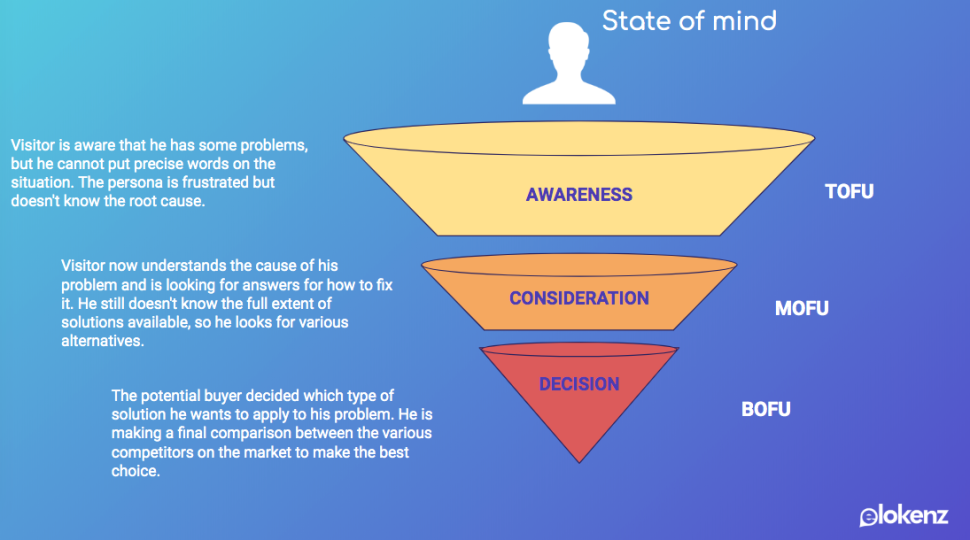
Each stage of the Buyer’s Journey is linked to a distinct set of search intents… which also translates to a different set of content types. If you are in the decision stage, you will probably be comparing up solutions, and you will be happy to read products comparison sheets. However, if you are just at the awareness stage, educative content will be more useful to you.
Content types and Buyer’s journey
Of course, your content marketing strategy should take into account the fact that people are not consuming the same type of content along the buyer’s journey. In our content plan we need to work on several distinct types of “content offers”.
For people searching about their problem at the Awareness stage, broad content is the key. You will probably address fundamental topics, with some theory, tips. The following types are usually associated with this stage:
- Blog posts
- Videos
- Infographics
- eBooks and White papers
When you are producing content for visitors in the consideration stage, your focus should be much more narrow. People will be more knowledgeable so their time and state of mind will not be the same as before. What typically works at that stage:
- Webinars
- Product comparisons
- Checklists
- Reviews
- Expert spec sheets
Finally, when you address specifically people in the decision stage, you have to be very pragmatic and provide them with material that will help them to choose you like:
- customer case studies
- ROI calculators
- Pricing tables
- Product showcase / Demo
- Datasheets
This is summarized in the following image:
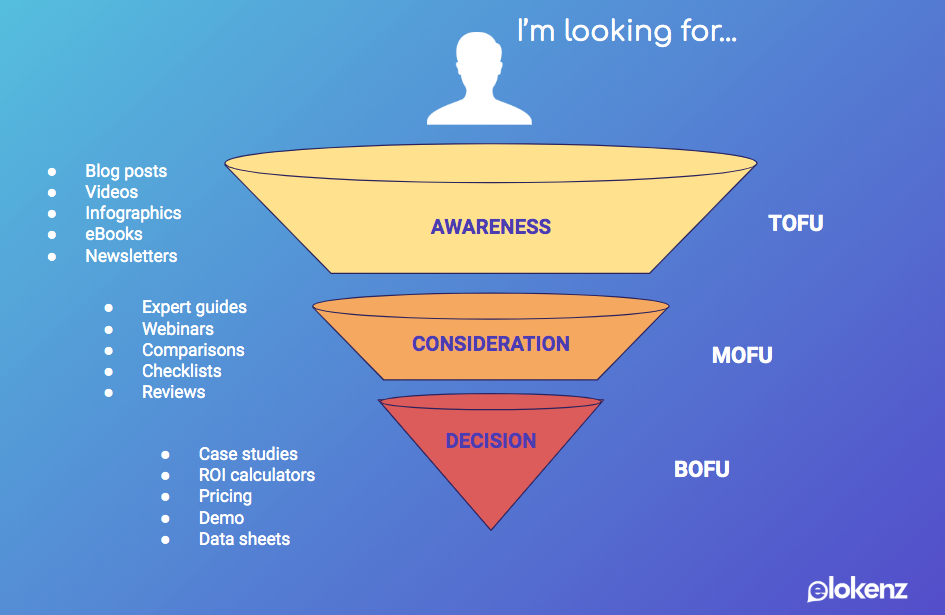
Now you should have a good grasp on the different aspects we have to take into account when writing down your content strategy.
Content marketing inbound mapping
Let’s combine all this together into a comprehensive simple framework. The goal is to have a visual summary of all your decisions into one single array so that you can share it with all your content team (copywriters, editors, decision-makers, …) to align content marketing efforts. All the content ideas will be quickly accessible into one matrix (this is your documented content strategy).
The objective is to list down all the personas challenges you discovered during your research phase and use them as the center of your ideation process. Since all content will be related to a persona’s pain, it means that you should always be relevant to your readers. These will be the “topics” of your content strategy.
—
Practically, you can save all your knowledge in documents such as Doc files or spreadsheets. Be sure to pick a tool where you can collaborate easily and such that everyone is sure to use the latest version (you don’t want your copywriter to use an old deprecated persona). To make things easier, we have prepared a free Airtable template to guide you.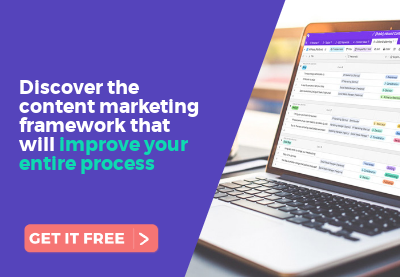
Airtable is a free tool and it’s like a spreadsheet on steroids. If you are uncomfortable with the format, you can also open our template and export it to Sheets or Excel.
—
Here are the first two tabs that will allow you to record the core of your content strategy in one single place.

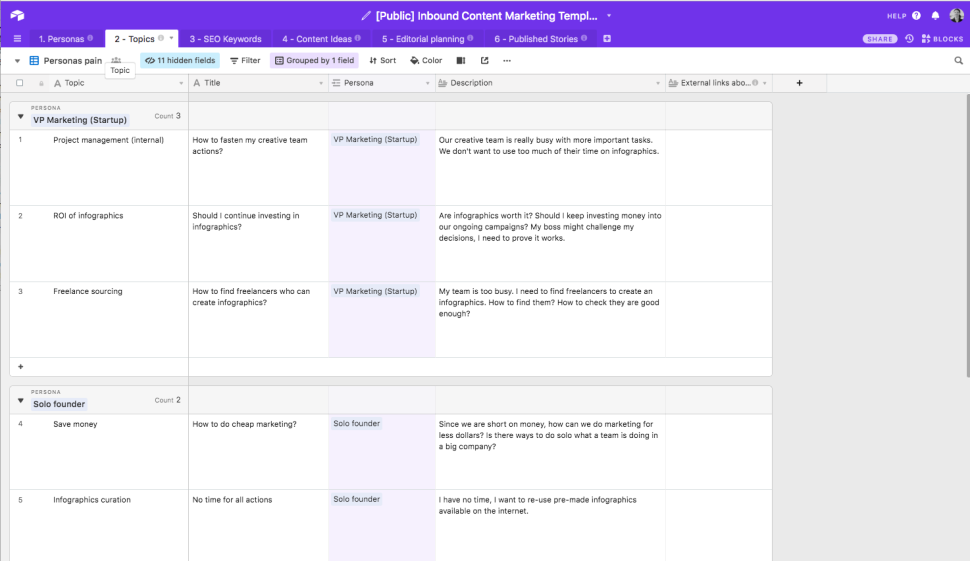
3 – Perform an SEO Audit to find keywords for each topic cluster
Researching your persona has helped you to decide what topics to address with your content. Now you need to know what your personas will type on Google to solve their challenges. Hopefully, during the interviews, you had the opportunity to catch expressions and words used by your targets.
You can’t do that task on your own but obviously many tools (free or not) will help you here. The ultimate goal for you is to have a list of keywords + traffic estimates for each topic you decided to address.
Finding traffic estimates is the last step of a long work of keyword sourcing. Before that, you have to start somewhere. It could be by looking at:
- Google Trends to get the related topics of a given expression, or
- existing traffic-generating keywords on Google Search Console
- Similar searches (Google suggest – “People also asked for” – AnswerThePublic)
- Tools such as Google Keyword Planner, Semrush or Ubbersuggest (all of which will give you traffic estimates)
Once you have a list of expressions for each topic (try to get at least 50 terms for each topic), you have to get the related traffic estimate. Here at Elokenz, we use Semrush which offers a very practical interface to classify topics and analyze keywords in batch. But Semrush is not free, and you might prefer to use Google Keyword planner instead.
This will help you to prioritize some topics or some expressions when you write your content.

4 – Fill your inbound content map
You should now have completed all the research phase. You know your personas and their challenges, and you know how they can express their concerns with words. It is now time to brainstorm to create content addressing these challenges and fitting in one of the buyer’s journey stages.
The inbound content map will help you to cover broader topics and situations for every single persona. We have prepared an Airtable template to get you started.

After the initial brainstorm session, you can allow your content team to submit ideas on a continuous fashion (you can set up a form to submit ideas) or you can set periodical brainstorm sessions to keep filling up your inbound content map.
5 – Editorial calendar and content creation
Now the foundations are in place, it’s time to bring the copywriters in (or to warm up your keyboard if you are also taking care of this part of the job). You know who should write for and what to write about, your team now should define when it will publish the various content. This takes the shape of an editorial calendar where everyone can see what is expected.
In this step you will decide which pieces of content will be published, in which order, and who will be in charge. The goal here is to build a calendar for the coming weeks to get everyone busy while setting achievable deadlines. You want to regularly produce content, but the quality shouldn’t be dismissed.
Clear and public publication dates should be an incentive for the team, not a stressing warning while they work. You can introduce some gamification, and celebrate when authors manage to deliver in time.
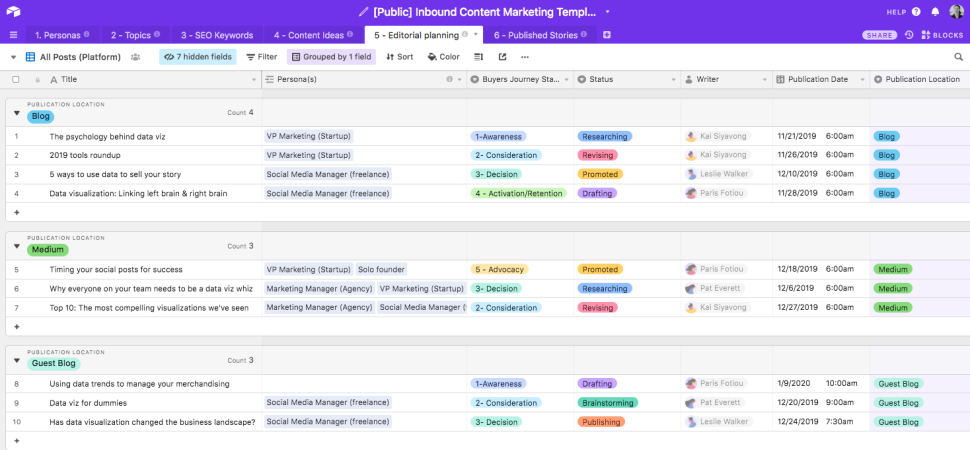
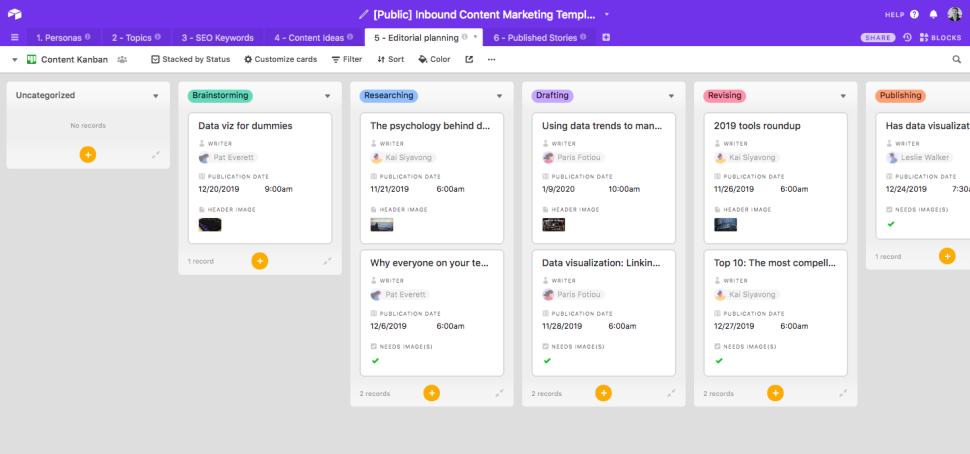
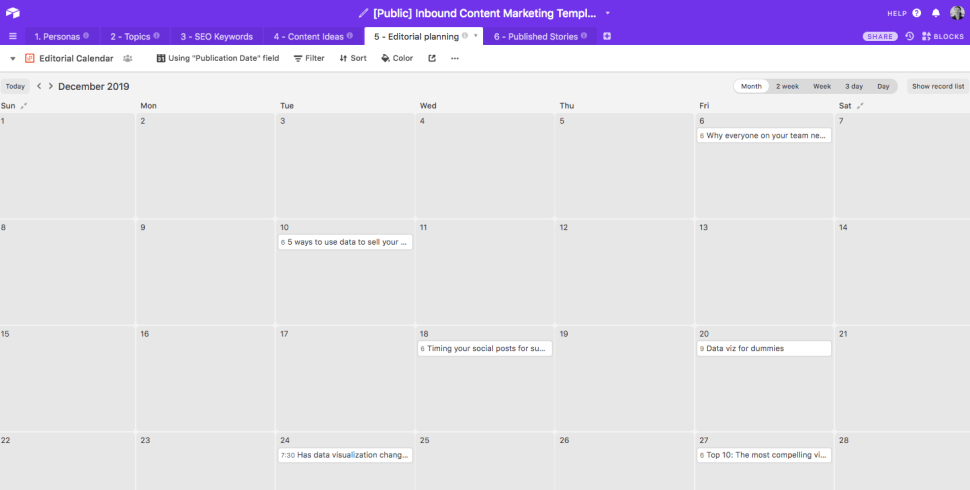
6 – Content distribution
You probably know what we think at Elokenz: creating your content is only one half of the job. We created Repost to make the second half, content distribution, less “painful” but also (and above all) more efficient when it comes to acquiring new leads.
Distribution is indeed often the poor cousin of content marketing. Why is that? Well, probably because it became harder and harder with time. Everyone competes for content attention, so getting ahead of the crowd is complex. Having said that doesn’t help, so you need to brace yourself, and create your own content distribution process.
We will not enter into the details in this post because we will address the topic in detail on Elokenz Blog in the future. However, to give you some directions here, you need to understand that each content type requires a different distribution recipe.
Once you publish a blog post or a podcast episode, you will want to share it on your social media, in your newsletter, and ask some partners to relay your messages. To get efficient, the best thing we have found was to create a “distribution recipe” for each of our produced content type. The recipe is just a ToDo list (on Trello or Asana for instance) that tells us what we should do when a new piece has been produced.
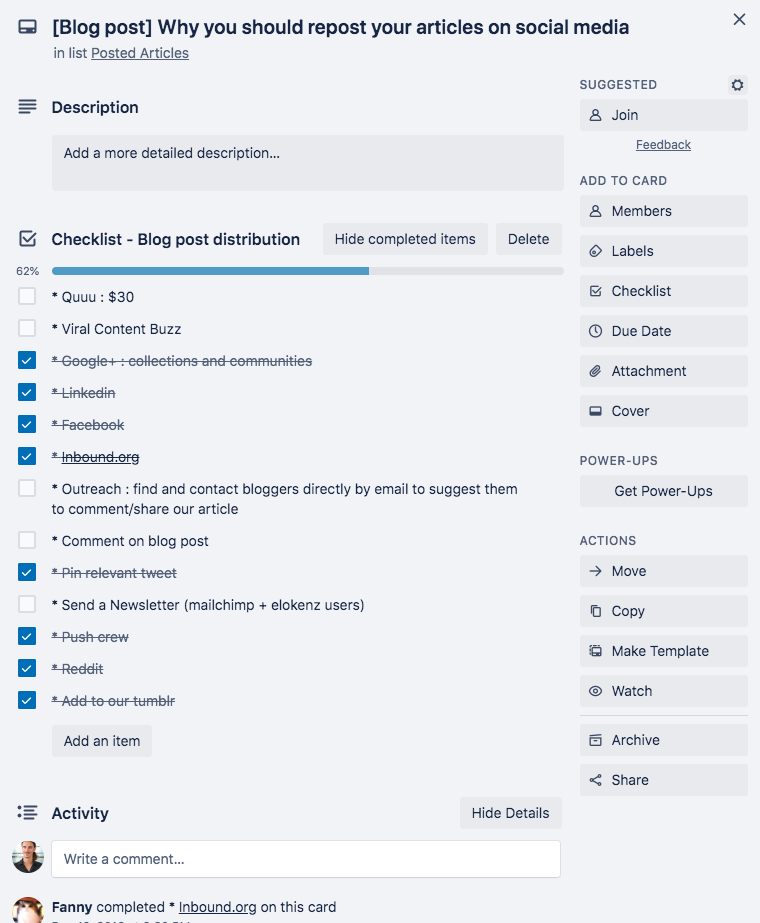
We’ll cover the topic later on this blog. If you want to be alerted when we publish the post, you can join 10 000 other content marketers in our mailing list.
7 – Track Key Performance Indicators (KPIs)
Let’s finally come back to the performance monitoring of your content (we already discussed the goals in the first section). In this article, as we focus on content creation for inbound marketing purposes, the main goal we have in mind here is lead generation. It means that you will follow traffic, conversions and finally the number of MQL generated.
To better drive your actions, it’s better to get insight into all the parameters from your strategy. So when you will collect analytics, you will need to retrieve stats per article but also per persona, per buyer’s journey stage and per topic.
Technically, it will be easy to track stats for the conversions (you can use Google Analytics content grouping feature), but it will be difficult for you to know how many leads turn into MQLs for each “content marketing” metrics.
Let’s first look at the conversions. You can implement a special tag in each of your pages, to send information such as “persona”, “topic” and “buyer’s journey” up to GA. In GA, you can create “content groups” to bucket all similar types together. Here is what it looks like in practice:
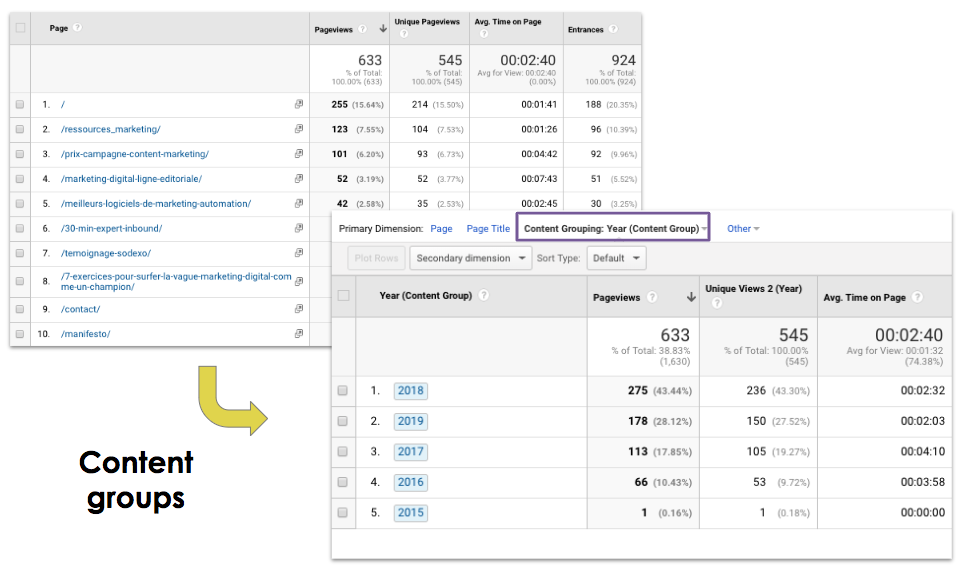
To tag each of your articles, you can use specific plugins (here we developed our own plugin, if you’re interested, let us know with a comment).
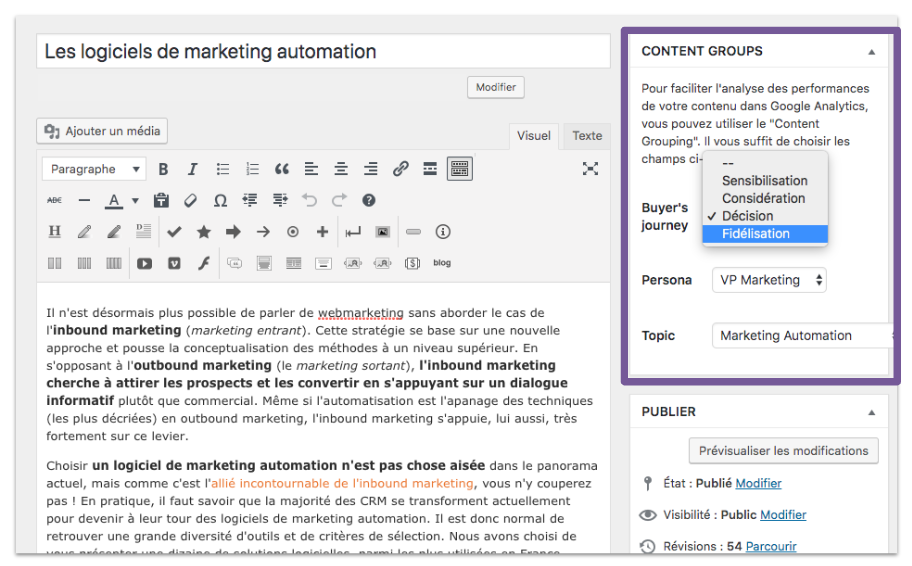
Once all your setup is ready, you can track your performance in Google Data Studio (free dashboard tool):
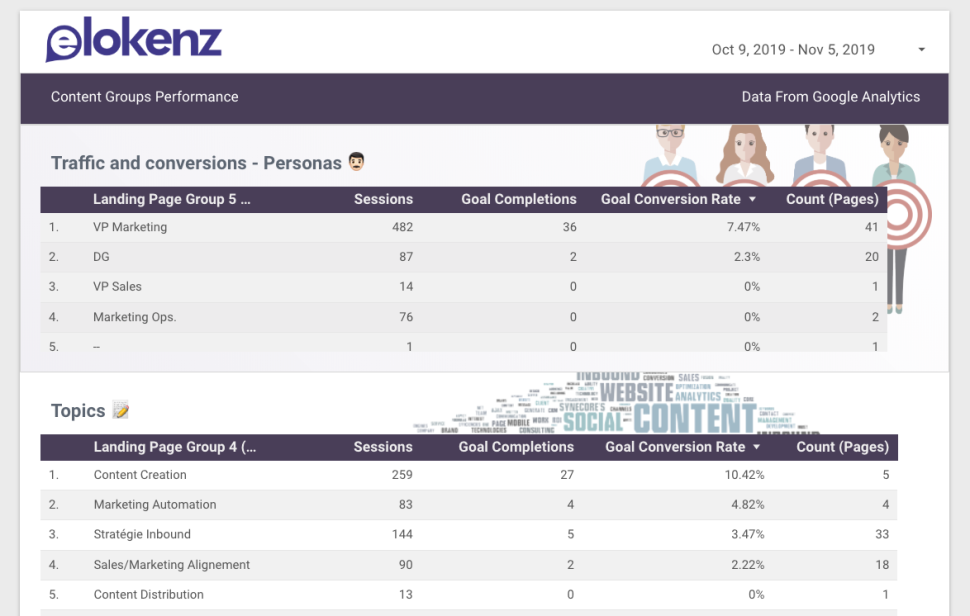
Setting up a content marketing dashboard will allow you to track how each topic or each persona is performing. You can track the following two KPIs:
- organic traffic: how many users land on your pages from an SEO search
- conversion rate: how many visitors convert after reaching your pages
You can set goals for these two metrics for each important group: “we want to reach 500 visits for the persona ‘VP Marketing’ this month, and reach a 5% conversion rate”. If we look at the picture above, we can see that we reached that goal. It’s up to you set realistic goals and to carefully mobilize your resources to achieve them.
Conclusion
We’ve covered the steps for your content marketing strategy creation in some depth in this post. We hope it will allow you to build a lasting process in your organization. You will probably need to adjust it several times to fit your team, your tools, and your processes.
The framework we described is based on several content marketing missions we delivered to mid-sized French companies. It works well for teams with up to 5 or 6 copywriters. If you lay the foundations in the right way, all your future efforts will be more efficient and you will ultimately get more qualified leads from your content.
If you have remarks or questions, feel free to drop a comment. We’re particularly interested in keeping this post up to date with your tips, so share it with the community.
